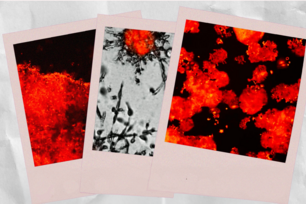Gene responsible for hereditary cancer syndrome found to disrupt critical growth-regulating pathway

When mTORC1 (red) receives signals from amino acids, it moves to lysosomes (green) and is activated. mTORC1 does not move to the lysosomes in cells with FLCN knocked down (right), compared to cells with normal FLCN function (left).
Zhi-Yang Tsun/Whitehead Institute
CAMBRIDGE, Mass. – Whitehead Institute scientists report that the gene mutated in the rare hereditary disorder known as Birt-Hogg-Dubé cancer syndrome also prevents activation of mTORC1, a critical nutrient-sensing and growth-regulating cellular pathway.
This is an unexpected finding, as some cancers keep this pathway turned on to fuel their unchecked growth and expansion. In the case of Birt-Hogg-Dubé syndrome, the mutated gene prevents mTORC1 pathway activation early in the formation of tumors. Reconciling these opposing roles may give scientists a new perspective on how cancer cells can distort normal cellular functions to maintain their own harmful ways.
Cells use the mTORC1 (for “mechanistic target of rapamycin complex 1”) pathway to regulate growth in response to the availability of certain nutrients, including amino acids. Whitehead Member David Sabatini and other researchers have teased apart many components of this pathway, but the precise mechanism by which nutrient levels are actually sensed has remained elusive. Recently, Sabatini and his lab determined that a family of proteins known as Rag GTPases act as a switch for the pathway—when nutrients are present, the Rag proteins turn on the mTORC1 pathway.
Now, several members of the Sabatini lab, including graduate student Zhi-Yang Tsun, have determined that the FLCN protein acts as a trigger to activate the Rag protein switch. Their work is described in the November 7 issue of the journal Molecular Cell.
“Zhi has ascribed a molecular function to this protein, and that’s a major contribution,” says Sabatini, who is also a Howard Hughes Medical Institute investigator and a professor of biology at MIT. “For the first time, we have a biochemical function that’s associated with it. And in my view, that’s an important first step to understanding how it might be involved in cancer.”
Before Tsun’s work, very little was known about FLCN’s role in the cell. In the early 2000s, scientists determined that mutations in the gene coding for FLCN caused the rare cancer Birt-Hogg-Dubé syndrome, but the syndrome’s symptoms offered little insight into FLCN’s molecular function.
Birt-Hogg-Dubé syndrome causes unsightly but benign hair follicle tumors on the face, benign tumors in the lungs that can lead to collapsed lungs, and kidney cancer. The syndrome is an autosomal dominant disorder, which means that a child inheriting one mutated copy of the FLCN gene will eventually develop the syndrome. Currently, the disease is managed by treating symptoms, but no cure exists.
FLCN’s dual roles—as a cause of a rare cancer in its mutated form and as a trigger for a growth pathway that is often hijacked in cancer cells—has prompted Tsun and Sabatini to rethink how a mutation can push cells to become cancerous.
“Basically, the mTORC1 pathway is essential for life,” explains Tsun. “So when you lose this nutrient switch or if it can’t be turned on, then the cell seems to freak out and cause all other growth promoting pathways to be turned on to somehow overcompensate for this loss. And this is actually what we see in patient tumors.”
For Birt-Hogg-Dubé syndrome patients and their families, better understanding of FCLN’s function moves the field one step closer to developing a therapy.
“Usually diseases are first described, then the responsible gene or genes are identified, and then that gene’s molecular function is figured out,” says Tsun. “And you need to know the gene’s function before you can start working on drugs or therapy. We’ve done that third step, which is a very important discovery for these patients.”
This work is supported by the National Institutes of Health (NIH grants CA103866 and AI47389), Department of Defense (DoD grant W81XWH-07-0448), National Cancer Institute (NCI grant F30CA180754), David H. Koch Graduate Fellowship Fund, National Science Foundation (NSF), Jane Coffin Childs Memorial Fund for Medical Research, and Howard Hughes Medical Institute (HHMI).
* * *
David Sabatini's primary affiliation is with Whitehead Institute for Biomedical Research, where his laboratory is located and all his research is conducted. He is also a Howard Hughes Medical Institute investigator and a professor of biology at Massachusetts Institute of Technology.
* * *
Citation
Tsun, Z. Y., Bar-Peled, L., Chantranupong, L., Zoncu, R., Wang, T., Kim, C., ... & Sabatini, D. M. (2013). The folliculin tumor suppressor is a GAP for the RagC/D GTPases that signal amino acid levels to mTORC1. Molecular Cell, 52(4), 495-505.
Contact
Communications and Public Affairs
Phone: 617-452-4630
Email: newsroom@wi.mit.edu


